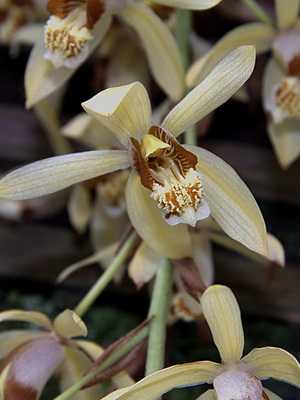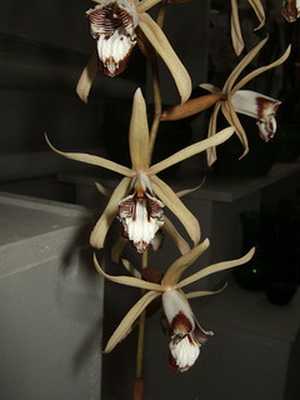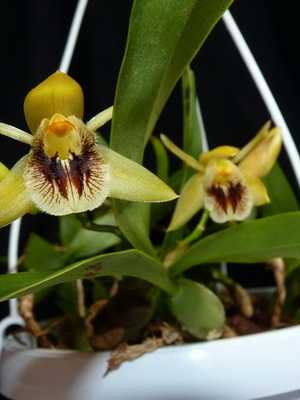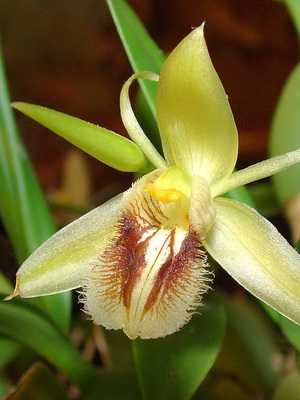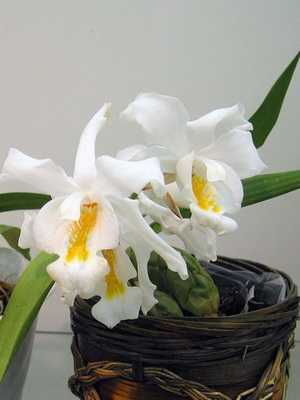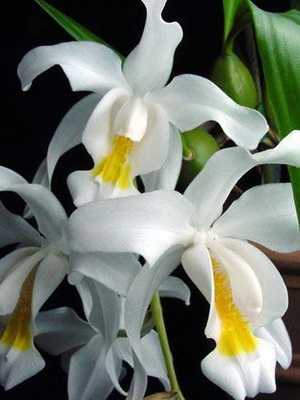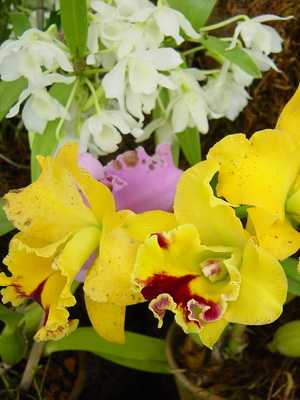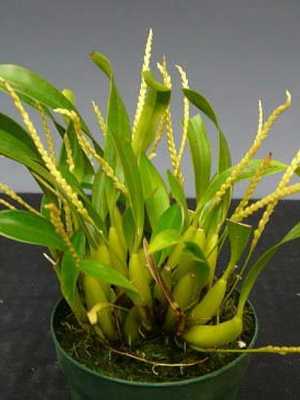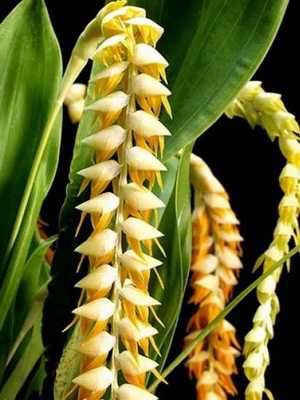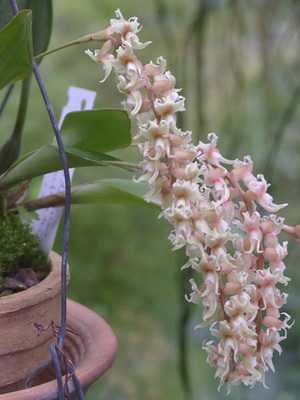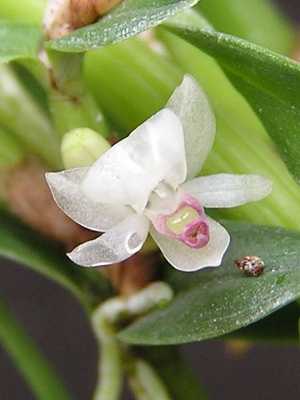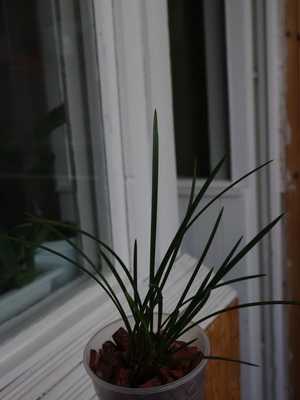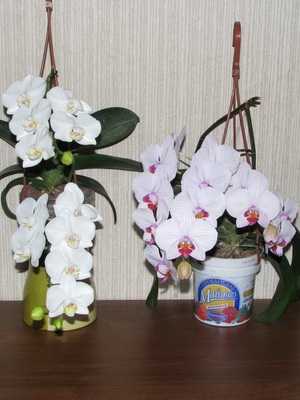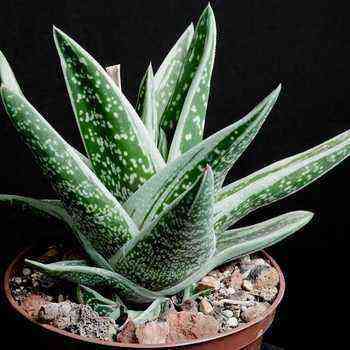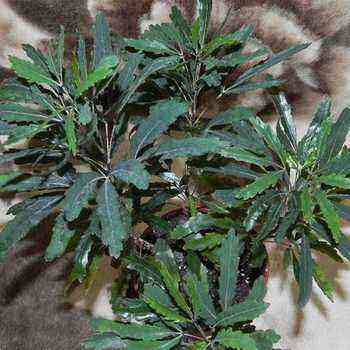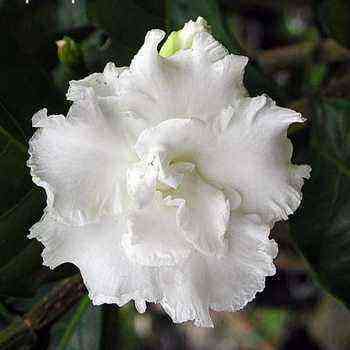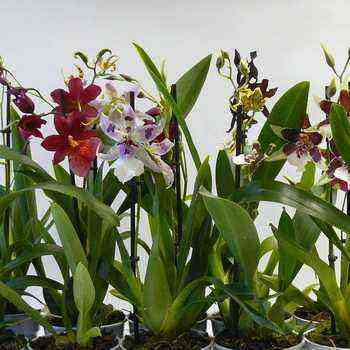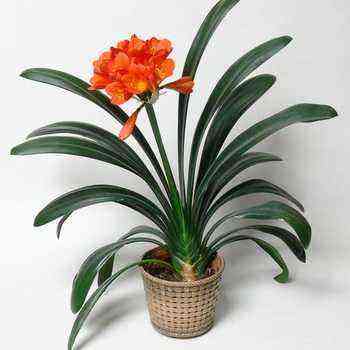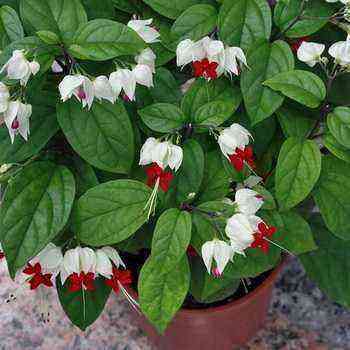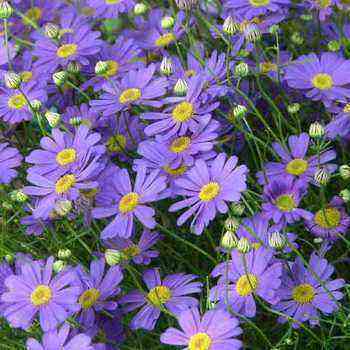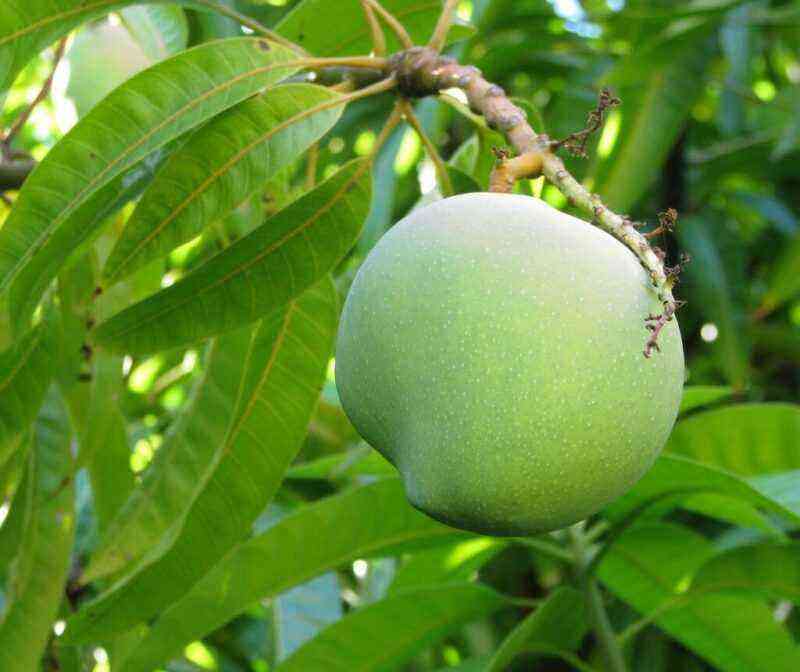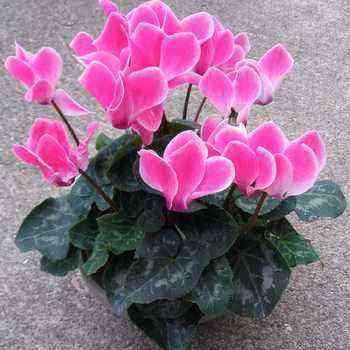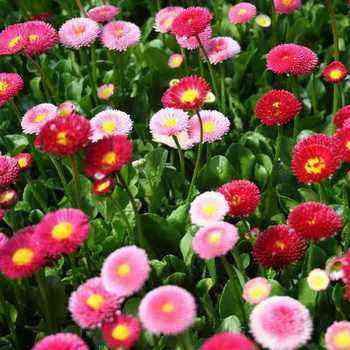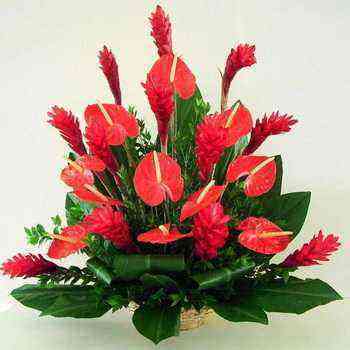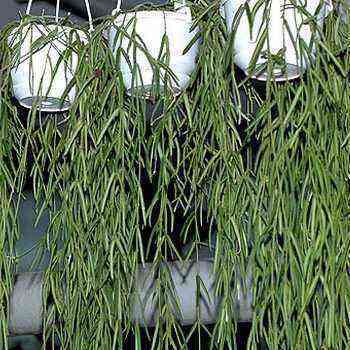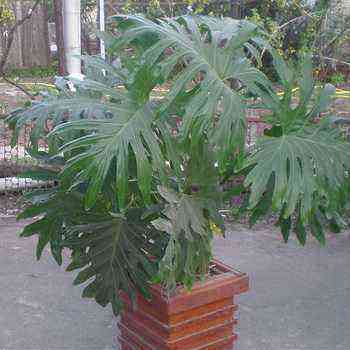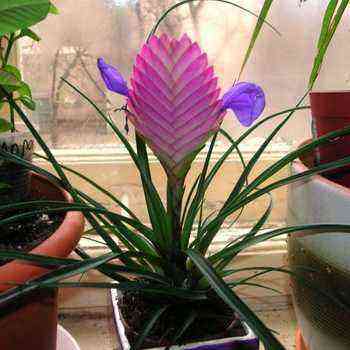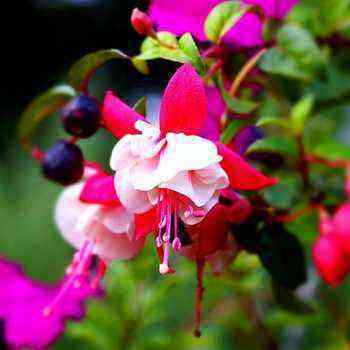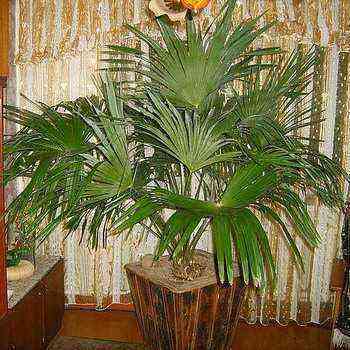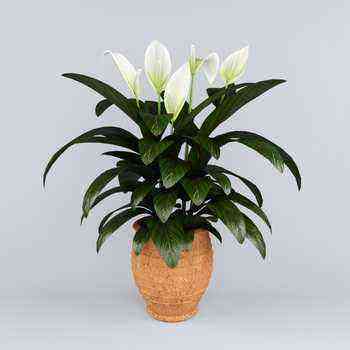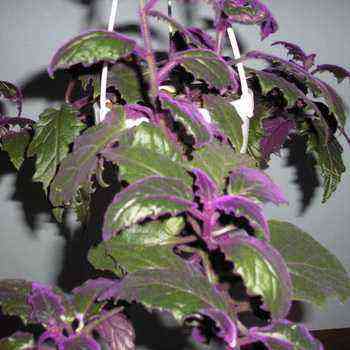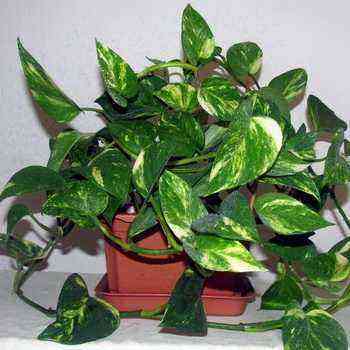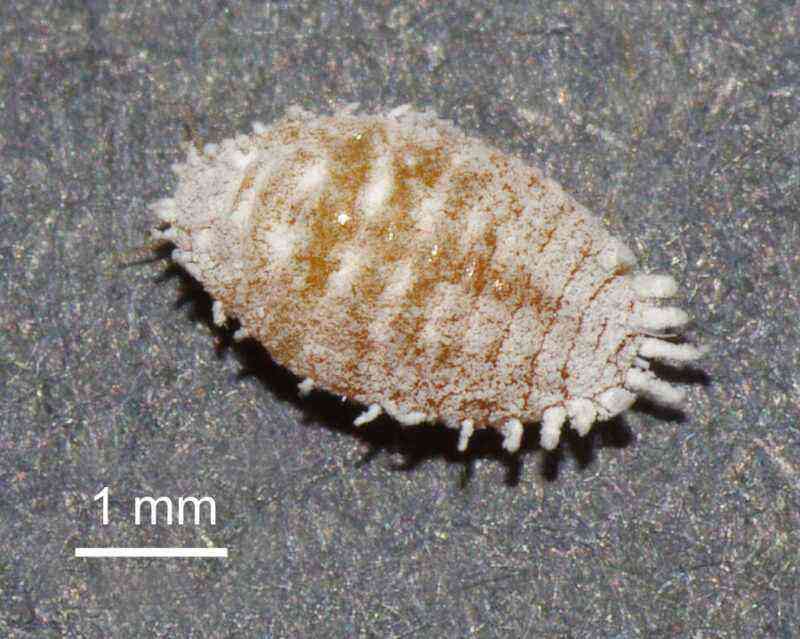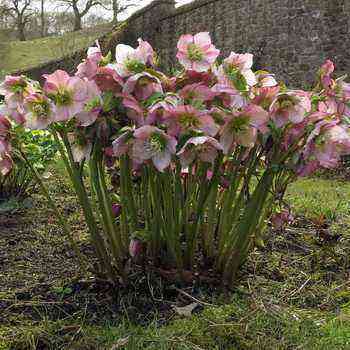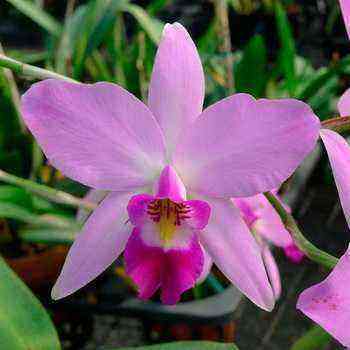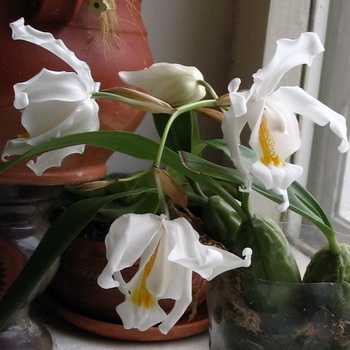
The name of the celloginine orchid comes from the Latin koilos, which means a depression in the column of an orchid flower.
Most orchid species in this spectacular genus of epiphytic and lithophytic plants are distinguished by white or greenish flowers with a contrasting lip. Some species of flowers have an exquisite aroma.
Celogin Massange (Coelogyne massangeana) – a large plant with elongated ovate, slightly furrowed bulbs and large petioled leaves. Flower racemes up to 60-80 cm long, drooping with yellowish-white flowers, with small brownish specks on the lip and with a weak aroma.
Celogin Day (Coelogyne dayana) – a rather large plant with a long inflorescence up to 1 m long, bearing many spectacular flowers. The cellogyne has thin, ovoid pseudobulbs bearing two apical leaves with longitudinal grooves. The lip is white with a chocolate brown pattern and white scallops; the rest of the perianth is creamy white. This orchid needs a moderately warm room, partial shade and a constantly damp substrate. The homeland of this species is Thailand, the Malacca Peninsula, Kalimantan, Java and Sumatra.
Tselogina fringed (Coelogyne fimbriata) – miniature orchid. Oval double-leaved pseudobulbs do not exceed 3 cm in length. The flowers are creamy-brown in color, the lip is fringed with a red-brown pattern. This species needs a fairly cool, shady and humid environment and blooms from August to November. Pot culture is preferred.
Tselogyna comb
The most famous species of the genus, which has become widespread in culture due to its relative unpretentiousness, is Coelogyne cristata; it grows wildly in the mountain forests of the Himalayas. Bulbs, ovoid or round-tetrahedral, bear 1-2 sessile leaves.
Flowers are white with a lip in yellow-orange marks, with a delicate aroma, collected in 5-9 pieces in loose, relatively short drooping racemes. Blooms in January-March.
Care of the Cologne
Celogynes are considered one of the easiest plants to cultivate. They prefer coolness and adapt very well to any home environment. Caring for cellogyne is not at all difficult, provided that you provide these plants with abundant, diffused lighting. From the beginning of summer to October, celloginum is watered with soft water evenly and abundantly, in winter watering is minimal.
In the spring and summer, orchids are fertilized every two weeks; in the autumn-winter period, feeding is not required. Most cellogyne species should be grown in pots in pine bark substrate, but cellogyne species with long, drooping clusters are best grown in hanging baskets.
Orchid playone and its photo
Pleione (PLEIONE) is a genus of miniature spectacular terrestrial orchids related to cellogyne, which includes about 25 species and several hundred artificial hybrids, which bloom profusely in early spring in a leafless state. Among them there are epiphytic orchids and orchids leading a terrestrial lifestyle.
Look at the photo of the plione – the flowers of these orchids are similar to those of the cattleya. They appear in the spring and are single or paired. Playone was first described by botanist David Don in 1825. Registered as a separate genus only in 1903.
The most famous species is playone beautiful (Pleione formosana) originally from East China and Taiwan.
It is the most winter-hardy species of the whole genus. Large flowers with a diameter of 10 cm are distinguished by a wide variety of shades of pink, but there are also pure white forms.
Glazed balconies and loggias are chosen for placement. Starting from the moment of planting, they are kept in a cool, bright place, moisturizing by spraying. When the orchid starts growing, the first watering is done. After flowering, watered more often. In hot summer, watering is done daily. In culture, it is advisable to apply fertilizer with each watering.
The name was given to the plant in honor of the mythological nymph, daughter of Ocean and the nereid Tethys (aka Thetis). Translated from Greek, Pleione means “destined to increase in numbers.” The nymph gave birth to a whole constellation, now called the Pleiades. And thanks to the peculiar shape of the flower, reminiscent of a regal peacock, the playone is called “peacock orchids.”
At the beginning of September, the playon is watered for the last time and until October-November the bulbs are allowed to ripen. The transplant is carried out at the end of January, beginning of February. Bulbs are cleaned of traces of the old substrate and the roots are cut. For planting, a soil mixture of pine bark, sphagnum and perlite is used (2: 3: 1).
Dendrochilum orchid
Dendrochilum (DENDROCHILUM) Is a large genus of unifolia sympodial orchids native to the Philippines, Borneo and Sumatra. The name comes from the Latin dendron – “tree”, cheilos – “lip”.
Most of them are epiphytes that grow in rainforest mountain tropical forests. Dendrochilum flowers bloom once a year on a new growth; they are small but brightly colored.
Quite popular in culture – dendrochylum longifolia (Dendrochilum longifolium) Is a type of orchid that is common in New Guinea, but also occurs in Indonesia, Malaysia and parts of the Philippines. The flower stalks of this type of orchid are very long, longer than the leaves, and bear about 40 small green flowers with a very strong spicy aroma.
Dendrochilum is best grown in pots, for miniature species, a substrate of pure sphagnum moss is suitable, larger species of dendrochilum prefer to grow on a substrate based on pine bark with the addition of small amounts of gravel, perlite and finely chopped moss.
Orchids of this genus require fresh air and constantly high humidity.

